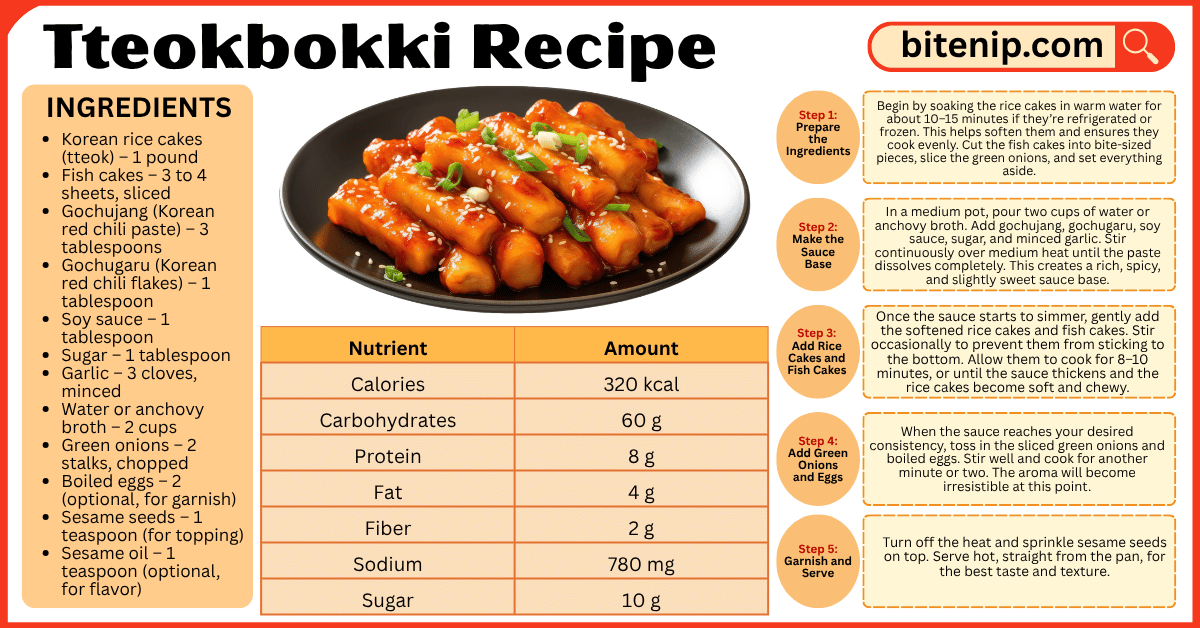Tteokbokki is one of Korea’s most iconic comfort foods. Known for its chewy texture, fiery red sauce, and mouthwatering aroma, it has become a global street-food favorite. This beloved dish combines simplicity with bold flavors, offering the perfect balance of sweet, spicy, and savory in every bite. Whether you’re new to Korean cuisine or already a fan, Tteokbokki is a must-try that never fails to satisfy cravings.
Origin of Tteokbokki
The history of Tteokbokki traces back to Korea’s royal courts during the Joseon Dynasty. Originally, it wasn’t spicy at all. Early versions were made with soy sauce and vegetables, known as Gungjung Tteokbokki. However, after the introduction of red chili peppers in Korea, the modern version evolved into the spicy dish we know today. It quickly gained popularity as a street food, sold from small stalls known as pojangmacha. Over time, Tteokbokki became a symbol of Korean street culture and youthful energy.
Ingredients of Tteokbokki Recipe with Pictures
- Tteok (Rice Cakes)
The star of the dish, providing chewiness and body. They absorb the sauce beautifully, making every bite flavorful.

- Gochujang (Korean Chili Paste)
Adds spice, depth, and color. It’s the heart of the sauce and gives Tteokbokki its signature heat.
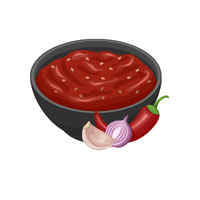
- Gochugaru (Korean Chili Flakes)
Enhances the spicy kick while contributing to the sauce’s vibrant red hue.

- Fish Cake
Offers a subtle umami flavor that balances the sweetness and spiciness.

- Soy Sauce
Brings saltiness and depth to the sauce.

- Sugar
Balances the heat and gives the dish a hint of sweetness.

- Garlic
Adds aromatic richness and warmth.
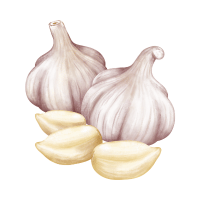
- Green Onions
Give freshness and color, cutting through the bold flavors.
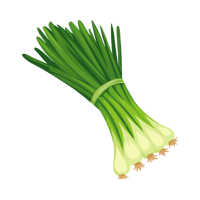
- Water or Anchovy Broth
Serves as the base of the sauce, ensuring a smooth consistency.

- Boiled Eggs (Optional)
Make the dish heartier and add protein.
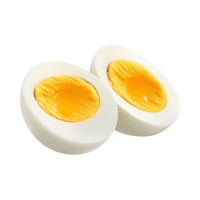
Ingredients with Quantities
| Ingredient | Quantity |
|---|---|
| Korean rice cakes (tteok) | 300 g |
| Korean fish cakes | 100 g |
| Gochujang (chili paste) | 3 tbsp |
| Gochugaru (chili flakes) | 1 tbsp |
| Soy sauce | 1 tbsp |
| Sugar | 2 tbsp |
| Minced garlic | 2 cloves |
| Green onions | 2 stalks |
| Water or anchovy broth | 2 cups |
| Boiled eggs (optional) | 2 |
| Sesame seeds (for garnish) | 1 tsp |
Step by Step Tteokbokki Recipe
Step 1: Prepare the Ingredients
Begin by soaking the rice cakes in warm water for about 10–15 minutes if they’re refrigerated or frozen. This helps soften them and ensures they cook evenly. Cut the fish cakes into bite-sized pieces, slice the green onions, and set everything aside.
Step 2: Make the Sauce Base
In a medium pot, pour two cups of water or anchovy broth. Add gochujang, gochugaru, soy sauce, sugar, and minced garlic. Stir continuously over medium heat until the paste dissolves completely. This creates a rich, spicy, and slightly sweet sauce base.
Step 3: Add Rice Cakes and Fish Cakes
Once the sauce starts to simmer, gently add the softened rice cakes and fish cakes. Stir occasionally to prevent them from sticking to the bottom. Allow them to cook for 8–10 minutes, or until the sauce thickens and the rice cakes become soft and chewy.
Step 4: Add Green Onions and Eggs
When the sauce reaches your desired consistency, toss in the sliced green onions and boiled eggs. Stir well and cook for another minute or two. The aroma will become irresistible at this point.
Step 5: Garnish and Serve
Turn off the heat and sprinkle sesame seeds on top. Serve hot, straight from the pan, for the best taste and texture.
Common Mistakes to Avoid
1. Not Soaking the Rice Cakes:
Skipping this step often leads to unevenly cooked rice cakes. Soaking softens them and helps absorb the sauce better.
2. Overcooking the Sauce:
When overcooked, the sauce becomes too thick and sticky. Always simmer gently and stir often to maintain a smooth texture.
3. Using Too Much Gochujang:
While gochujang gives flavor, too much can overpower the dish. Balance it with sugar and soy sauce for harmony.
4. Ignoring Broth Quality:
Using plain water instead of anchovy broth results in a less flavorful sauce. Broth deepens the umami taste.
5. Cooking on High Heat:
High heat causes the rice cakes to harden quickly. Medium heat ensures even cooking and better consistency.

Tips for Perfect Tteokbokki Recipe
1. Use Fresh Rice Cakes:
Fresh rice cakes yield the best chewiness. If you use frozen ones, ensure they’re fully thawed and soaked properly.
2. Adjust Spiciness:
Customize the heat level to your taste. For a milder version, reduce gochugaru or add a teaspoon of honey to mellow the spice.
3. Add Extra Toppings:
Enhance texture by adding cabbage, ramen noodles, or cheese. Each addition transforms the dish into something uniquely delicious.
Popular Variations of Tteokbokki Recipe
1. Cheese Tteokbokki:
Melted mozzarella on top balances the spice with creamy richness. It’s a trendy twist loved by younger generations.
2. Ramen Tteokbokki (Rabokki):
Combining instant noodles with Tteokbokki makes a heartier meal. The noodles soak up the sauce beautifully.
3. Seafood Tteokbokki:
Adding shrimp, squid, or mussels introduces a savory ocean flavor, creating a luxurious version perfect for special occasions.
Serving Suggestions
Tteokbokki pairs wonderfully with side dishes like odeng (fish cake soup) or kimchi. It’s best enjoyed hot, straight from the pan, with a sprinkle of sesame seeds and chopped green onions. For an extra kick, drizzle a bit of sesame oil before serving. It’s ideal as a snack, party dish, or even a full meal.
Nutritional Information (Per Serving)
| Nutrient | Amount |
|---|---|
| Calories | 320 kcal |
| Carbohydrates | 60 g |
| Protein | 8 g |
| Fat | 4 g |
| Fiber | 2 g |
| Sodium | 780 mg |
| Sugar | 10 g |
Why People Love Tteokbokki Recipe ?
People adore Tteokbokki because it’s both comforting and exciting. The chewy rice cakes combined with spicy-sweet sauce create an addictive contrast. Moreover, it’s easy to customize and perfect for sharing. Its vibrant red color and bold aroma also make it visually irresistible.
Benefits of Tteokbokki Recipe
1. Great Source of Instant Energy
Rice cakes are made primarily from glutinous rice, which is rich in carbohydrates. This means Tteokbokki provides a quick burst of energy, perfect for busy days or when you’re feeling low on stamina. Unlike sugary snacks, the slow-digesting carbs in rice cakes give a steadier release of energy.
2. Boosts Metabolism
The star ingredient, gochujang (Korean chili paste), contains capsaicin, a compound known for boosting metabolism. Capsaicin slightly raises body temperature, which can help burn calories faster. As a result, enjoying spicy Tteokbokki occasionally might support better metabolism.
3. Comfort Food for the Soul
Beyond nutrition, Tteokbokki is pure comfort. The warm, spicy sauce and chewy texture provide emotional satisfaction, especially during cold weather or stressful days. Eating it often brings back fond memories for many people, making it more than just a meal — it’s an experience.
4. Packed with Flavorful Nutrients
When made with anchovy broth, garlic, and green onions, the dish also offers trace minerals and antioxidants. Garlic supports immunity, while green onions are rich in vitamin K and vitamin C. This makes the meal not only flavorful but also slightly nutritious when balanced properly.
5. Customizable for Better Nutrition
Tteokbokki can easily be made healthier. You can add vegetables like cabbage, carrots, or spinach to increase fiber and vitamins. Including boiled eggs or tofu adds protein, making the dish more filling and balanced.
Disadvantages of Tteokbokki Recipe
While Tteokbokki is undeniably tasty, it does have a few drawbacks that are worth keeping in mind.
1. High in Sodium
One of the biggest concerns is the sodium level. Both gochujang and soy sauce contain salt, and when combined, they can make the dish quite salty. Consuming too much sodium can lead to water retention, bloating, or even high blood pressure over time. So, moderation is key.
2. Contains Added Sugar
The sauce typically includes sugar to balance the spice, which increases its calorie count. For those watching their sugar intake or managing diabetes, this can be problematic. Using natural sweeteners or reducing the sugar amount can help make it healthier.
3. Low Protein Content
Traditional Tteokbokki mainly consists of rice cakes and sauce, which means it’s high in carbs but low in protein. This might leave you feeling hungry sooner after eating. Adding eggs, fish cakes, or tofu can help solve this issue.
4. May Be Too Spicy for Some
The spiciness that many love can be overwhelming for others. People with sensitive stomachs, acid reflux, or digestive issues might experience discomfort. For them, reducing the spice level or mixing in cheese can make it gentler on the stomach.
5. High-Calorie When Overeaten
Though it seems light, Tteokbokki can be calorie-dense due to the rice cakes and sauce. Eating large portions frequently may contribute to weight gain, especially if paired with fried sides or sugary drinks. Enjoying it occasionally and mindfully helps keep it balanced in your diet.
FAQs
1. Can I make Tteokbokki less spicy?
Yes, simply reduce gochujang or mix in honey or cheese for balance.
2. What can I use instead of gochujang?
You can combine chili paste with a bit of soy sauce and sugar, though the flavor won’t be exactly the same.
3. Are rice cakes gluten-free?
Traditional Korean rice cakes are gluten-free, but always check the packaging.
4. How do I store leftovers?
Keep them in an airtight container in the fridge for up to two days.
5. How do I reheat Tteokbokki?
Add a little water or broth and reheat on low heat to restore the sauce.
6. Can I make it vegetarian?
Yes, skip fish cakes and use vegetable broth instead.
7. What type of rice cakes work best?
Cylinder-shaped ones are preferred for classic Tteokbokki.
8. Can I freeze cooked Tteokbokki?
It’s better to freeze the sauce separately; rice cakes may become hard.
9. How long does it take to cook?
From start to finish, about 20 minutes.
10. What can I serve with it?
Pair it with kimchi, fried dumplings, or Korean fried chicken for a complete meal.
Conclusion
Tteokbokki perfectly captures the essence of Korean comfort food — bold, flavorful, and deeply satisfying. Its rich history, versatility, and comforting warmth make it a global favorite. With this easy recipe, you can bring a taste of Seoul’s street food right into your kitchen. So, next time you crave something spicy and heartwarming, give Tteokbokki a try — you won’t regret it.

